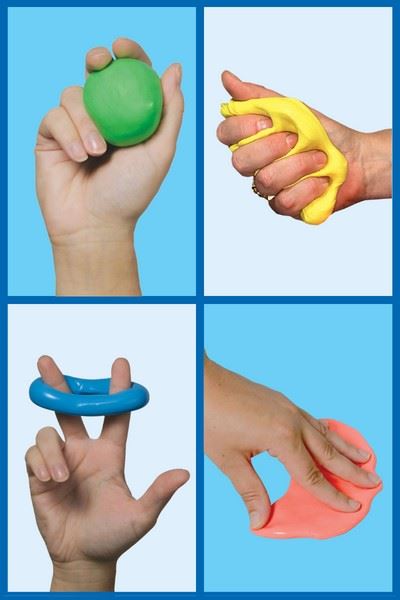-
Home
-
The Benefits of Using Therapeutic Putty for Hand Exercises
The Benefits of Using Therapeutic Putty for Hand Exercises
October 19, 2023
 Whether you're typing on a computer, washing dishes, or playing an instrument, you depend on your hands to get the job done. Hand injuries, surgery, and certain medical conditions can limit your ability to carry out these activities. Therapeutic putty hand exercises are a popular choice for individuals seeking to improve hand and finger function. In this article, we explore the potential benefits of incorporating therapy putty into rehabilitation and wellness routines.
Whether you're typing on a computer, washing dishes, or playing an instrument, you depend on your hands to get the job done. Hand injuries, surgery, and certain medical conditions can limit your ability to carry out these activities. Therapeutic putty hand exercises are a popular choice for individuals seeking to improve hand and finger function. In this article, we explore the potential benefits of incorporating therapy putty into rehabilitation and wellness routines.
What is Therapeutic Putty?
Therapy putty is a type of flexible, moldable material that's designed to help strengthen the muscles in your hands and fingers. It's commonly used in hand therapy to help patients recover from injuries or conditions that impact the strength and function of their hands.
Therapy putty comes in a variety of colors and resistance levels ranging from extra soft to extra firm. Different levels allow individuals to choose the ideal putty that caters to their specific needs. Some types of putty even have antimicrobial properties for better infection control.
Benefits of Therapeutic Putty Hand Exercises
Therapeutic hand exercises using putty offer a multitude of benefits for individuals seeking therapeutic relief and improved hand mobility. These benefits include improving hand strength, circulation, and dexterity. They are also easy to use in any location and can be used for stress relief.
Improved hand strength: The resistance of the putty can help strengthen weak hand muscles and improve grip strength. Many exercises that use therapy putty involve squeezing, stretching, or pinching motions, working your way up the resistance levels as your hands get stronger. With consistent and targeted training, individuals can increase overall hand strength.
Improved circulation: Hand exercises with putty promote increased blood flow to the hands, which can reduce stiffness and swelling associated with conditions such as arthritis. This can also help with circulatory problems in the hands due to an injury, surgery, or chronic condition.
Improved dexterity: Therapeutic putty exercises can improve dexterity in your hands and fingers, helping you get back to activities that require fine motor skills—from daily chores to art and music. Some exercises might involve picking up small objects out of the putty, which requires both more coordination and control. Puttycise® Tools, for example, can be pushed, pulled, or turned in the putty to simulate a range of functional activities.
Ease and convenience: Therapeutic putty hand exercises are a fun and easy way to strengthen your hands, and they're something you can do at your own pace in the comfort of your own home. The putty is easy to take with you, so you can practice hand or finger exercises anytime, anywhere.
Stress relief: Squeezing putty can also be a stress-relieving exercise that helps reduce anxiety and tension. The rhythmic motion of kneading, shaping, or stretching the putty promotes relaxation, allowing you to release built-up stress.
How to Use Therapeutic Putty for Hand Exercises
Therapeutic putty exercises can help improve grip and finger extension as they provide resistance for hand muscles and joints, forcing them to work and stretch. A physical therapist can recommend specific exercises depending on your needs and goals, but some common examples include pressing, pinching, squeezing, and spreading motions.
- Hand Press: Place the putty into the palm of your hand and press your fingers through the putty until your fingertips reach your palm, resulting in a fully clenched fist. Release your fingers and roll the putty in your hands to reshape before repeating the exercise.
- Finger Pinch: Roll the putty into a ball and pinch it using your fingers and thumb, with either straight or curved fingers. If you have difficulty moving each finger individually, start by pressing all fingers into the putty at once and work towards pinching with each individual finger.
- Finger Squeeze: Roll the putty into a ball, place it between two spread fingers, and squeeze those fingers together in a scissor-like motion. Repeat this exercise using different resistance levels and different pairs of fingers as needed.
- Finger Spread: Roll the therapy putty out and loop it around two fingers in a donut shape. Spread your fingers apart, repeating the exercise with different fingers as needed and increasing the resistance level of the putty as your strength improves.
Hand Therapy for People with Arthritis
Arthritis is a common condition that impacts the joints, leading to discomfort and restricted mobility. Impaired hand function can pose challenges, particularly when it comes to everyday activities like grasping objects or lifting them.
Therapy putty can be a valuable tool to enhance joint mobility, expand range of motion, and strengthen the hands and fingers. In addition, it can help alleviate common arthritis symptoms such as pain, stiffness, and swelling. Incorporating therapy putty into rehabilitation plans or everyday routines can yield improvements for those suffering from arthritis.
Therapeutic putty hand exercises are a simple yet highly effective way to improve hand strength, dexterity, and circulation as part of your rehabilitation plan. Always remember to consult with a healthcare professional or physical therapist before starting any new hand exercises, especially if you're recovering from an injury or surgery. They can provide guidance and tailor a specific rehabilitation plan to meet your individual needs and goals
AliMed offers a wide range of hand and finger exercisers—including several types of therapy putty—to meet a variety of individual needs and rehabilitation goals.